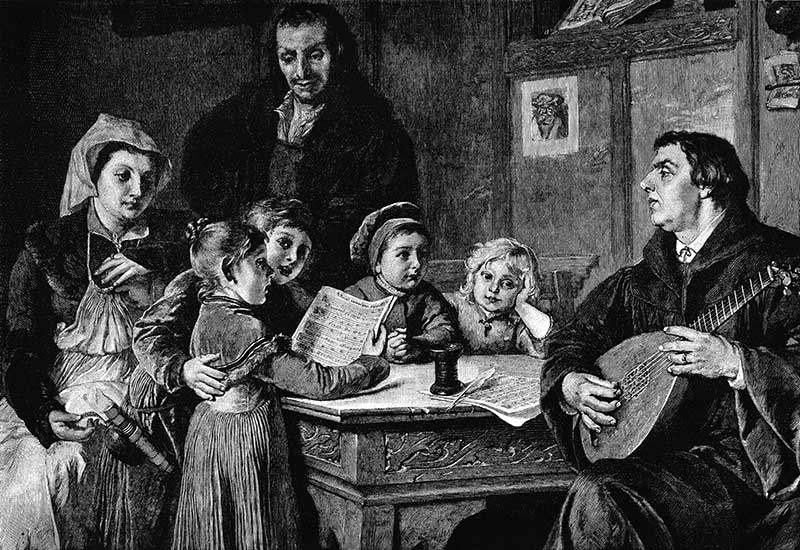Feature
As Goes Sweden
Neo-Pagan Family Policies Doom Any Recovery by Allan Carlson
My people come from the old Swedish province of Småland. It lies to the southwest of Stockholm: a landscape of hills, forests, and rocks. Indeed, the fields are so rocky that Småland has been called the "kingdom of stones." In some respects, Småland resembles the highlands of the American South: that long swathe of big hills that runs from western Virginia to southern Missouri and Arkansas. Småland is, in a way, Sweden's southern Appalachia.
And there are similarities among their respective populations as well. The Scotch-Irish became America's hill people—our hillbillies. Clan-oriented, they held strongly to the liberties they had won from centuries of border wars, primarily with the English (think of Braveheart).
Despite their material poverty, the Smålanders, too, fought for centuries to preserve their liberties. Unlike other parts of Sweden, Småland was never enserfed: no barons or lords ever ruled over my people, exacting feudal dues. The Smålanders were free peasants, owning the farmsteads that their ancestors had carved out of a harsh landscape. They gave allegiance only to their local, popularly chosen chieftains and—occasionally—to a king, if he had earned it.
The women of Småland were strong as well, long before the label "feminist" was coined. Physically, they were muscular, the result of hard work on hardscrabble farms. Legally, by ancient custom, these women held equal claim to land and other hard assets, relative to their husbands and brothers. In this regard, they were probably unique in all of Europe.

Stubbornness & Faith
The Smålanders were also a stubborn people. Once they embraced a faith, they held on to it. As Christianity spread into Scandinavia during the 900s, for example, theirs was the last part of Sweden to stay loyal to the old pagan gods of the North: to Thor, Odin, Freya, Loki, and the rest. In his fine historical novel The Long Ships, Frans G. Bengtsson describes the Swedes in transition from pagan Vikings to Christians. In this account, the Smålanders are the last, most violent, and most merciless of the pagans, known for killing or enslaving dozens of missionary priests. As one of these, Fr. Willibald, tells the hero of the book, Orm:
"I am not a vain man and do not hanker after fame or honor. Nonetheless, I should feel that my life's work had been well rewarded if I could become the first priest to baptize a Smålander. For there is no known instance of such a thing ever having been done before; and if it could be brought to pass, great indeed would be the rejoicing in Heaven."
In the book, Orm assists Fr. Willibald in gaining that first baptism, and heaven did rejoice. For by the end of the twelfth century, the Smålanders had become Christians, more or less, with loyalty to the bishop of Rome.
Early in the sixteenth century, though, the Swedes won independence from Danish rule. Their new king, Gustav Vasa, decided also to cast off allegiance to the pope of Rome, to follow instead the teachings of Martin Luther. Perhaps this was a genuine conversion. Or perhaps the king found merit in the Protestant disdain for ornamentation in churches. Certainly, he was happy to relieve the parishes of Småland and elsewhere of their jeweled chalices and golden crucifixes. As Lutherans, the king reasoned, the peasants would no longer need such idolatrous baubles.
Once again, though, the Smålanders refused to give up their new Old Faith. In the 1540s, the Småland peasantry rose in revolt against their king, led by the free peasant Nils Dacke. The Smålanders wanted their priests back; they wanted their chalices and crucifixes back; they wanted the monasteries reopened. Since Gustav Vasa had also closed the border to trade, and since the Smålanders relied primarily on the sale of cattle to the Danes to make a living, they demanded as well their ancient freedoms to buy and sell goods with other peoples. Moreover, since King Gustav Vasa had banned their ancient Ting, or free parliament, to be replaced by his appointed governor and his tax collectors, these Smålanders insisted on restoration of their old political liberties.
Religious freedom (of a sort); free trade; lower taxes; and "small" government: this Dacke revolt was, I suppose, a sixteenth-century Swedish predecessor to our current Tea Party revolt—although the Smålanders preferred real weapons to talk shows. And for a time, they succeeded. Dacke gathered a force of over ten thousand "forest bandits"—the king's phrase—and crushed a royal army led by professionals, and including a thousand skilled German mercenaries. The path to Stockholm was undefended. Alas, to make a long story short, Dacke was an honest, somewhat naive man, and he succumbed to the lies, deceptions, and ruthlessness of the king. In the end, the monarch crushed the Dacke revolt. The Lutheran priests returned, backed by a new German mercenary army, and the Smålanders became Lutherans.
Move forward now another 400 years. Although Sweden remained neutral during the Great War of 1914–1918, the consequences of that conflict spread to the Scandinavians as well: Royal power surrendered completely to full-scale political democracy; aristocracies and other inherited hierarchies were dismantled; socialism emerged to fill the vacuum with a drive for sweeping economic democracy; and secularism—the rejection of religious faith—replaced the common European attachment to the ideal of Christendom, still dominant as late as 1914. By the 1970s, these shifts had coalesced into what we can call a new paganism.
Once again, though, the Smålanders resisted these changes. While attendance in the state Lutheran churches declined, the free churches, the Pentecostal churches, the Salvation Army, and the Baptist churches held their own or grew. Through the balance of the twentieth century, the old territory of Småland remained in a way as a refuge of Protestant Christian Sweden. When an authentic Christian Democratic party took form in this new Sweden, its electoral base also rested among the descendants of the old Småland peasants.
Plummeting Fertility
What, though, is the nature of the new Swedish paganism, dominant elsewhere in the land?
Allow me a personal story. In 1976, I spent several months in Sweden, doing dissertation research on the origins of that nation's distinct family policy system, dating from the 1930s. Several times I interviewed a woman named Alva Myrdal in her medieval-era home on Västerlånggatan Street in Stockholm's Old City. While not well known in the United States, hers was (and still is) a household name in Sweden, as the nation's foremost twentieth-century feminist and as an architect of the modern Swedish welfare state. At the time, Myrdal served in the Swedish cabinet as Minister of Disarmament and Church Affairs. For her disarmament work, she would later win the Nobel Peace Prize. As Minister of Church Affairs, she was then in the process of selecting two new bishops for the Church of Sweden, the Lutheran state church. During the interview, she laughed about the matter, saying, "You know the remarkable thing is that here I sit—a committed socialist and a lifelong atheist—choosing the next leaders of the Church of Sweden."
The episode surely highlights one peril of a too-close relationship between church and state. It also underscores the tight connection between secularization, public policy, and family decline in twentieth-century Europe, with Sweden as my example.
The background here is the plummeting fertility of the European peoples, a continent-wide development, first recorded in the 1920s and 1930s and evident again beginning in the mid-1960s. In the year 2012, the whole of Europe (from Iceland to European Russia) recorded a total fertility rate (TFR) of only 1.58, meaning that the average European woman will bear 1.58 children during her lifetime, only 75 percent of the level needed to replace a generation. In that same year, over twenty European nations already recorded an absolute decline in numbers, with deaths outnumbering births.
Within a decade, all European nations—with the possible exception of Albania—will predictably be in the same circumstance. In northern Europe, marriage is increasingly rare, replaced by cohabitation; in southern Europe, young adults increasingly avoid both marriage and cohabitation, refusing to form childbearing unions of any sort. This is the essence of the joint European family and population crisis of the twenty-first century.
A Tale of Two Countries
We can see a somewhat exaggerated illustration of this crisis and its geopolitical implications by comparing the populations—past, present, and future—of two lands: Orthodox Russia and the poor, Arab, Muslim nation of Yemen, a place sometimes called the Appalachia of the Middle East, a country of hill people who, it is said, have gun racks on the backs of their camels. (Or perhaps you could call them the Smålanders of Arabia.) In 1950, the territory that now composes Russia had a population of 103 million. Following World Wars I and II, there was a large surplus of females over males; still, the population there showed some signs of the "pyramid" typical to a growing nation: lots of children at the base; relatively few old people at the top. Yemen, in contrast, was a tiny nation of 4.3 million, with only four percent of the Russian population figure.
By the year 2000, sharp fertility decline was evident among the Russians, with a shrinking number of children, especially—and oddly—after the fall of communism. Still, because of past momentum, its overall population climbed to 145 million. Yemen, meanwhile, with a total fertility rate of nearly eight births per woman during these years, grew to 18.3 million, a fourfold increase.
A projection to the year 2050 comes from United Nations demographers. They predict an increase in Russia's fertility rate of 50 percent by 2050. Even so, Russia's population tumbles by 40 million to only 104 million, leaving a shrunken nation heavily tilted toward the elderly. The UN demographers also project a decline in Yemeni fertility by 60 percent, to 3.35. Even so, Yemen's population would still grow to 102 million, almost equal to that of Russia, and featuring large numbers of restless young people in a dry and crowded land.
We might also compare the 25 nations of the European Union to the 25 Muslim countries in North Africa and West Asia. Using very optimistic assumptions for Europe (namely, a rise in the total fertility rate of 30 percent and the annual entry of 500,000 immigrants), the European population still falls from 451 million in 2000 to 400 million in 2050; while the population of North Africa and West Asia more than doubles, from 587 million in 2000 to nearly 1.3 billion by 2050. If these numbers prove true, the migratory pressure on Europe from these Muslim nations—already great—will become enormous—indeed, uncontrollable.
Sweden to the Rescue?
However, modern Sweden now charges to Europe's rescue, with claims of a unique solution to the joint family and population crisis, a solution they say is applicable to all of Europe. A few years ago, the Swedish Institute for Future Studies, the government's propaganda arm for social and cultural matters, published a paper entitled "Gender Equality—A Key to Our Future?" The author, Lena Sommestad, perfectly outlines the Swedish family policy model for the European future—which is also the social side of the new paganism.
Professor Sommestad's essay claims that Europe's challenge of declining birth rates, population aging, tumbling marriage rates, and rising out-of-wedlock births has two sources: female emancipation, and "a crisis of the traditional European male breadwinner family." She says that nations such as Germany, Italy, and Spain, which have tried to protect or shore up the male breadwinner and his homemaking wife, have failed to understand the irrelevance of these roles for the future, and have paid the price with extremely low fertility.
Sweden, in contrast, has recognized women's full emancipation and complete gender equality as "social facts" and as the keys to a "sustainable" future. Professor Sommestad points to the theories of Alva Myrdal from the 1930s. The latter had also argued that under modern conditions, the breadwinner/homemaker model, premised on a family wage for fathers, could no longer produce a sufficient number of children. Myrdal insisted that, instead, "declining fertility rates should be fought with increased gender equality." This idea, Professor Sommestad admits, went dormant in Sweden in the 1940s and 1950s, when, during a time of affluence and relative policy conservatism, male-breadwinner families became common in Sweden. (Indeed, another author calls this "the golden age of the Swedish housewife.") However, "from the 1960s and onwards, a growing number of Swedish women returned to gainful employment, and by the early 1970s, the two-breadwinner norm had been firmly established." Today, Sommestad continues:
Swedish gender equality policies build on a strong tradition of pro-natalist and supportive social policies. . . . No entitlements are targeted at women in their capacity as wives. The state uses separate taxation, generous public day-care provision for pre-school children, and extensive programs of parental leave to encourage married women/mothers to remain at gainful employment.
During the 1930s, Alva Myrdal had used the birthrate crisis as "a battering ram" for radical feminist social reform. Dr. Sommestad now does so again, although this time on a larger European canvas. She adds that "countries that [support] non-martial cohabitation or extra-marital births have a better chance of maintaining higher fertility levels." Moreover, the Swedish model shows that to raise the birth rate, men must also take on "a greater responsibility" for childcare.
In sum, using less lofty language, the Swedish model of family policy sees radical equity feminism as the answer to the fertility crisis. If Europeans want to survive in the twenty-first century, Sommestad argues, they should eliminate the full-time mother and homemaker, completely crush the family wage idea (via the male breadwinner), abolish the home as an economic institution, welcome out-of-wedlock births and cohabitation, push all women—especially actual or potential mothers—into the labor force, enforce strict gender equality in all areas of life, re-engineer men into childcare-givers, and embrace expensive state child allowances, parental leave, and public day care programs. The result—almost by magic—will be more babies!
These are not just the ideas of academics, I hasten to add. In its 2004 official statement of policy toward the European Union, the then socialist-led Swedish government summarized its goal in one sentence: "We want to see a Union that is open, effective, and gender equal." Let me underscore this: The attainment of the feminist agenda served as Sweden's primary purpose within the EU. This government statement from April 2004 elaborates: "Sweden has a particular responsibility for increasing the pace of gender equality efforts in Europe. . . . Gender equality aspects should be integrated into all areas of policy."
Birth Dearth Unsolved
What should we make of all this? To begin with, I do want to admit that there are aspects of the modern Swedish model of family policy that are attractive. To begin with, the Swedish system does a good job of bonding newborns to mothers and fathers, in the short run. The generous—albeit very expensive—"parents insurance" program provides new parents with 390 days of paid leave, at 90 percent of salary, and another 90 days at a lower allowance. This means that virtually all Swedish children enjoy full-time parental care during their first thirteen months of life (compared to only a third of infants in the United Sates). This also allows new Swedish mothers to breastfeed their newborns for longer periods. And even some of the more coercive aspects of Sweden's parents insurance program—such as the requirement that fathers take 45 days of the paid parental leave for the couple to receive the full benefit—have their human side: it turns out that Swedish fathers have a preference for taking their paid leave during Sweden's moose-hunting season!
But that's about it; the other claims made by advocates for the Swedish model—particularly the claim that this approach will be Europe's demographic salvation—quite simply vanish under scrutiny.
First, and despite claims to the contrary, the Swedish model of family policy has not solved the birth dearth in that land. During the last decade of Sweden's "breadwinner father/homemaking mother" era, 1960–1969, the nation actually had a fertility rate above the replacement level of 2.10, reaching 2.3 births per woman. Contrary to assertions by Alva Myrdal and Lena Sommestad, the "family policy" system of that era clearly succeeded with respect to population replacement. However, once Sweden implemented the new model, built on the deconstruction of marriage, out-of-wedlock births, working mothers, parents insurance, and day care, fertility fell by 30 percent, to 1.6, by 1983.
True, during the late 1980s, the number apparently started climbing again, reaching 2.1 in 1991, exactly replacement level. Progressive social analysts around the European continent shouted hosannas! Pagan Sweden had found the answer! But it did not last. By 1993, fertility was falling again, and by 2003, Sweden—at 1.54—was close to the European Union average. Indeed, in the year 2000, Sweden joined that grim group of nations where deaths actually exceeded births—more coffins than cradles. In subsequent years, the birthrate drifted up again, driven in part by the high fertility of new Muslim refugee families. All the same, the number has remained significantly below replacement level.
It turns out that Sweden's so-called success in the early 1990s was a statistical fluke. A change in policy regarding eligibility for parents insurance, called a "speed premium," had the one-time effect of reducing the spacing between first and second births. This threw off the calculations of the total fertility rate, but the change did not significantly increase the total number of children born per family. Judged empirically, then, the Swedish model simply does not work; its so-called success is a Euro urban legend.
A Forced Revolution
Second, Professor Sommestad's brief history of the introduction of Sweden's new family policy during the 1960s grossly overlooks its radical and coercive nature. As honest Swedish feminist historians have admitted, there was no pressure for change coming from young Swedish housewives and mothers during the mid-1960s. By all accounts, they were largely happy with their situation. The pressure came from other directions. Government planners in the Labor Ministry, for example, foresaw labor shortages in Sweden's future. Instead of opening the doors to greater immigration or encouraging larger families, though, they decided to pull Sweden's young mothers into the workplace.
At the same time, the radical wing of Sweden's ruling Social Democratic party took power, inaugurating what feminist historian Yvonne Hirdman calls Sweden's "Red Years," 1967–1976. At their heart was a massive "gender turn" that would radically alter the nature of marriage and family in Sweden. In 1968, the Social Democrats joined with the labor unions in a joint report concluding that "there are . . . strong reasons for making the two-breadwinner family the norm" in all welfare and social policies. The next year, our old friend Alva Myrdal chaired a major panel "On Equality," which concluded that "in the society of the future . . . the point of departure must be that every adult is responsible for his/her own support. Benefits previously inherited in married status should be eliminated." The report also called for an end to tax policies that favored marriage.
Policy changes followed swiftly. In 1969, a Ministry of Justice committee declared Swedish marriage law "clearly anachronistic," based as it was on the now discredited Christian notion of "two becoming one flesh." Instead, the law should focus on the new imperative of "personal fulfillment." In 1971, Sweden's Parliament abolished the income tax system favoring marriage, so giving this land the most "fully individualized taxation system" in the world. According to analyst Sven Steinmo, this single change "more or less eradicated" the traditional home in Sweden. The Family Law Reform of 1973 introduced "no-fault" divorce, deeming it "only natural that if one of the spouses is dissatisfied, he or she may demand a divorce." All social and welfare benefits tied to marriage were abolished.
By the time the Social Democrats were voted out of office in late 1976, their forced revolution in family life was complete; the Swedes had been re-engineered into a post-family order. One of the oldest of socialist goals, one reaching back to the Communist Manifesto of 1848—"abolish the family" as a meaningful economic and legal entity—had been achieved.
The False Solution of Gender Equality
Moreover, Sweden—and Europe as a whole—now finds itself in new circumstances where the old calculations no longer apply. In the year 2000, a team of demographers reported in Science that Europe's population had reached a vital turning point. Until then, although fertility was abnormally low, the overall age structure of the continent still had a "positive momentum"; that is, long-term stability could still be gained if women raised their average family size to slightly over two children. In 2000, however, prior decades of low fertility produced a new situation. Europe's population entered into "negative momentum," meaning that a fertility rate of 2.1 would no longer suffice even to gain stability. A rate approaching four children per women would now be needed to achieve the same end.
Further, it is becoming increasingly clear that forced "gender equality" can never be the solution to fertility decline, no matter how hard feminist analysts work to cook the numbers. No less an authority than Joseph Chamie, director of the Population Division of the UN Department of Economic and Social Affairs, recently concluded:
While many governments, . . . non-governmental organizations, and individuals may strongly support gender equality at work and in the home as a fundamental principle and desirable goal, it is not at all evident how having men and women participate equally in employment, parenting, and household responsibilities will raise low levels of fertility. On the contrary, the equal participation of men and women in the labor force, child rearing, and housework points precisely in the opposite direction, i.e., below replacement fertility.
The Swedish model flies in the face of other well-documented causes of the decline in fertility. Australian John C. Caldwell, one of the world's most insightful demographers, has examined the dozens of rival theories behind what he calls "the fertility crisis in modern societies." He explores the perils of a liberal economy that creates doubts among women whether they should devote themselves to children. He dissects the special circumstances behind fertility decline found in Southern, Eastern, and Central Europe and in Asia. And he considers the effects of varied social policies on fertility, looking for common threads.
Caldwell concludes that the Swedish model works no better than any other social welfare model in countering depopulation. In the end, he admits that he can do no better than repeat the conclusion of Kingsley Davis from 1937, when the Western world faced a similar challenge: "the family is not indefinitely adaptable to modern society, and this explains the declining birth rate." More ominously, he adds, "a social order that does not reproduce itself will be replaced by another." The ancient Romans, who forced their own birth dearth, called such newcomers barbarians.
Under this explanation, the Swedish model stands doubly condemned. First, it represents an attempt to engineer a wholly new family system, which can only fail in the face of the constants of human nature grounded in the natural family. And second, the Swedish model represents a forced march of all its citizens into modern urban-industrialized society: the very problem to be overcome.
The Most Powerful Variable
The very extent of Europe's demographic implosion points to deeper causes. David Coleman has noted that remaining pockets of high fertility in Europe—such as the rural cantons of Switzerland—all disappeared around 1964, as did the pockets of higher "Catholic fertility" still to be found in Spain and Portugal. Dirk van de Kaa has reported that already by 1985, 97 percent of 21-year-old Danish women reported having had premarital sex, essentially marking the full collapse of the Christian sexual ethic there. Other researchers have shown that by 1985, only 20 percent of all European Community citizens above age 18 had a significant tie to organized religion; among young adults, the figure was closer to 10 percent. Ronald Inglehart has cited the sharp decline in votes for identifiably religious political parties in Europe after 1963 as a sign of what he calls "the silent revolution" in European values.
Importantly, Belgian demographer Ron Lesthaeghe underscores that "secularization"—defined as "the decrease of adherence to organized religion"—still serves as "the most powerful variable at the outset of fertility decline" and "the one with the longest-lasting effect or the highest degree of persistence." He sees plunging European fertility during the late twentieth century as simply continuing the "long-term shift in the Western ideational system" away from the values affirmed by Christian teaching (namely, "responsibility, sacrifice, altruism, and sanctity of long-term commitments") and toward a militant "secular individualism" focused on the desires of the self. And, as you might guess by now, Sweden leads Europe in measures of secularism and feminist-inspired individualism.
And yet, it is true that Europe's other, and older, family policy model—a system premised on the breadwinner/homemaker model of the 1950s—has also failed since 1970. Still found to some degree in Germany, this model encourages the full-time maternal care of children through the provision of state maternity benefits, child allowances, and homemaker pensions. All the same, Germany's fertility rate stands at 1.30, 16 percent below Sweden's already low figure.
This approach, which had worked effectively in the two decades following World War II, no longer does. Once again, the most likely explanation is "secularization," or the retreat from faith, the collapse of a vital Christian democracy into a state where atomistic individualism trumps Judeo-Christian family expectations. And so, unlike the pagans found in pre-Christian Scandinavia or in ancient Rus (the Viking kingdom from which Russia gets its name), modern European pagans do not reproduce.
Where the Future Lies
Where might worried Europeans—and, dare I admit, we citizens of an ever more paganized America—look for alternatives?
Eric Kaufmann's 2012 book, Shall the Religious Inherit the Earth?, offers a vastly different view of the human future. A political scientist at University of London and a self-identified secular liberal, Kaufmann nonetheless boldly concludes, "Religious fundamentalists are on course to take over the world through demography." (He uses the old American Protestant term "fundamentalists" here broadly to describe Jews, Christians, and Muslims worldwide who take their beliefs seriously enough to allow scriptural teachings on marriage and procreation to influence their behavior.) The future of the human race, he argues, lies with American Mormons, Old-Order Anabaptists, Haredi Jews, Salafi Islamists, Quiverfull Protestants, and even "Laestadian Lutherans," a sect found in the north woods of Finland and Sweden. These are groups still faithful to God's command, "Be fruitful and multiply." With fertility otherwise tumbling around the globe, these religious groups—with total fertility rates of between four and eight births per woman—are already expanding their relative share of the population. Compounded over four generations, the transition will prove staggering.
Kaufmann skillfully dismantles the modern liberal myth that secularism is on the march and will dominate the future. Instead, he argues, "We have embarked on a particularly turbulent phase of history in which the frailty of secular liberalism will become ever more apparent." This is an age of "ideological exhaustion," he suggests, when liberalism has joined communism, socialism, and fascism on the scrapheap of history. None of those idea systems, he asserts, is still able to motivate self-sacrificing behavior, such as the rearing of a relatively large family. At the same time, Kaufmann explains how the liberal values of tolerance and pluralism suck the life out of "moderate" religion, while allowing fundamentalist subcultures to emerge and grow. As he summarizes, "Secularism, like DDT, wiped out much of its opposition but also gave rise to new, resistant strains of religion."
Kaufmann gives extensive attention to several "Enlightenment-resistant" groups: the ultra-orthodox Haredi, who will shortly constitute the majority of all people in Israel, so displacing the low-fertility secular Jews who founded the country; the American Mormons, who are still increasing at a rate of 40 percent per decade; the "Quiverfull" Evangelicals, who reject the use of birth control; and the Old-Order Amish, who have expanded from 5,000 adherents in 1900 to more than 300,000 today. While "seculars" increasingly avoid marriage and children, these faith communities have rediscovered the biblical injunction to reproduce and have "thrived in the most individualistic, profane, Western societies."
The political effects of these changes, Kaufmann predicts, will be huge. Due to differential fertility between "seculars" and "fundamentalists," by 2100 "three-quarters of America may be pro-life. Their activism will leap over the borders of the 'Redeemer Nation' to evangelize the world." In the arena of Islam, secular forces (as found in modern Turkey) sow the seeds of their own demise: "Heads sharia wins, tails you lose." And in Europe, "at a key tipping point, secular liberals will replace [immigrants] as the conservative bogeyman, with Christians and Muslims joining forces to oppose secular Europeans." This will shift the main fault lines in European politics from ethnicity to faith. Kaufmann's closing words should instill fear in every secular pagan heart:
It will be a century or more before the world completes its demographic transition. There is still too much smoke in the air for us to pick out the peaks and valleys of the emerging social order. This much seems certain: without [a new secular] ideology to inspire social cohesion, fundamentalism cannot be stopped. The religious shall inherit the earth.
Dare I say, "May it be so"? •
Allan C. Carlson is the John Howard Distinguished Senior Fellow at the International Organization for the Family. His most recent book is Family Cycles: Strength, Decline & Renewal in American Domestic Life, 1630-2000 (Transaction, 2016). He and his wife have four grown children and nine grandchildren. A "cradle Lutheran," he worships in a congregation of the Lutheran Church-Missouri Synod. He is a senior editor for Touchstone.
subscription options
Order
Print/Online Subscription

Get six issues (one year) of Touchstone PLUS full online access including pdf downloads for only $39.95. That's only $3.34 per month!
Order
Online Only
Subscription

Get a one-year full-access subscription to the Touchstone online archives for only $19.95. That's only $1.66 per month!
bulk subscriptions
Order Touchstone subscriptions in bulk and save $10 per sub! Each subscription includes 6 issues of Touchstone plus full online access to touchstonemag.com—including archives, videos, and pdf downloads of recent issues for only $29.95 each! Great for churches or study groups.
Transactions will be processed on a secure server.
more on family from the online archives
more from the online archives
calling all readers
Please Donate
"There are magazines worth reading but few worth saving . . . Touchstone is just such a magazine."
—Alice von Hildebrand
"Here we do not concede one square millimeter of territory to falsehood, folly, contemporary sentimentality, or fashion. We speak the truth, and let God be our judge. . . . Touchstone is the one committedly Christian conservative journal."
—Anthony Esolen, Touchstone senior editor














